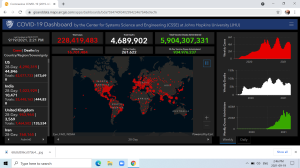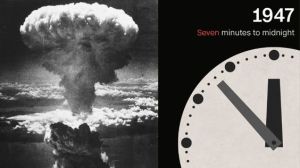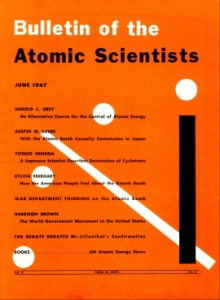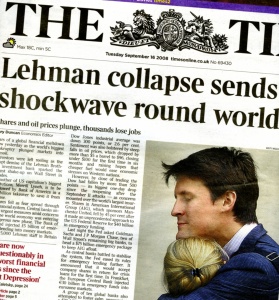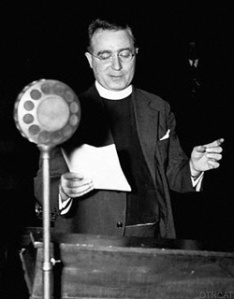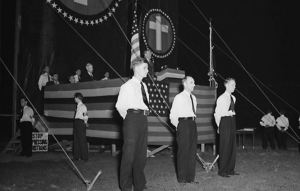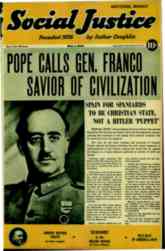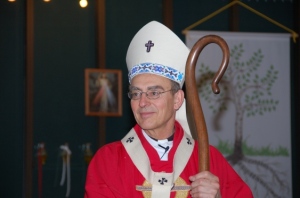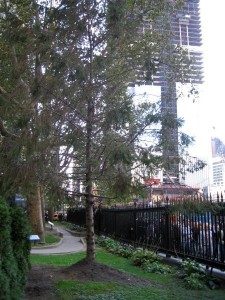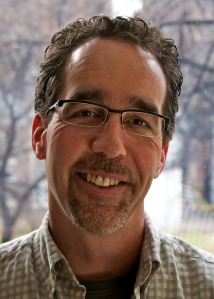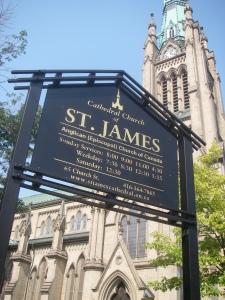



The Catholic blogosphere has been all atwitter in recent days over the defection of one of its highest profile Conservative writers, Canadian pundit Michael Coren, who was received on Sunday, April 19 into the Anglican Communion; to wit at the Cathedral Church of St. James on Church Street in Toronto, greeted outside by Rev. Canon Susan Bell, an honorary assistant at the cathedral and canon missioner for the Diocese of Toronto. St. James Cathedral is both a parish church ministering to the historic St. Lawrence neighbourhood and a cathedral church.
Coren, 56, was born in England and raised in a secular home, which he has described as “semi-culturally Jewish.” He says he became a Christian in 1984 and was received into the Roman Catholic Church in 1985 when he was 26. His wife, Bernadette, and four children are Catholic. They met in Toronto at a Chesterton conference held in 1986 to coincide with the 50th anniversary of the death of the legendary Catholic apologist – and perhaps someday saint – Gilbert Keith (G.K.) Chesterton. Coren moved to Canada from Britain in 1987.
“I could not remain in a church that effectively excluded gay people,” Coren told Joseph Brean of Toronto’s National Post newspaper in a May 1 story headlined,”‘I felt a hypocrite’: Author Michael Coren on why he left the Catholic Church for Anglicanism.” Coren went on to tell Brean, “That’s only one of the reasons, but for someone who had taken the Catholic position on same-sex marriage for so long, I’d never been comfortable with that even though I suppose I was regarded as being a stalwart in that position. But I’d moved on, and I felt a hypocrite. I felt a hypocrite being part of a church that described homosexual relations as being disordered and sinful. I just couldn’t be part of it anymore. I could not do that. I couldn’t look people in the eye and make the argument that is still so central to the Catholic Church, that same-sex attraction is acceptable but to act on it is sinful. I felt that the circle of love had to be broadened, not reduced.”
The Anglican Church of Canada into which Coren has been received is an autonomous national church within the Anglican Communion consisting of over 800,000 members on parish rolls. The Anglican Communion, representing those in communion with the Archbishop of Canterbury, derives their forms of worship and the orders of their bishops, priests and deacons from the Reformation settlement in England. Anglicanism worldwide shares a common liturgical and theological tradition, catholic and reformed, which is expressed in local contexts in a wide variety of languages and customs. While each national or regional church within the communion is autonomous, the Archbishop of Canterbury is its spiritual head and the chief sign of its unity.
The first Anglicans in Canada were 16th century English explorers led by Martin Frobisher and his chaplain, the Rev. Robert Wolfall.
The Anglican Church did not become established in Canada, however, until the consecration of Charles Inglis as bishop of Nova Scotia in 1787. The head of the Anglican Church of Canada is the primate – Archbishop Fred Hiltz of the Diocese of Nova Scotia and Prince Edward Island.
Personally, I’ve always found Michael Coren’s politics way too conservative for my taste, and his tone mean-spirited at times, although he showed evidence of mellowing in recent years, even while still a Catholic.
He penned a column on religious bookstores for the long-defunct Idler, a Canadian general interest magazine for intellectuals edited by David Warren, which was sort of a forerunner to The Walrus, for the November-December 1991 issue where he wrote: “The Evangelicals may be intolerant, small-minded, and repellent, but at least they hold a consistent set of beliefs.”
This is also not Coren’s first defection from the Catholic Church. He also left in 1994 to attend several evangelical churches, including Baptist, and also attended Anglican services, after he wrote a June 1993 Toronto Life profile on Cardinal Aloysius Ambrozic, then archbishop of Toronto, in which he accurately quoted Ambrozic as using the words “frigging” and “bitch” and calling the late Spanish dictator Francisco Franco “a conservative Roman Catholic and not a bad fellow.”
The Catholic Church “circled its wagons around Ambrozic” and Coren, who had been a Roman Catholic for about eight years, “was deluged with hate mail,” Toronto-based freelancer Ron Csillag, who joined Religion News Service in March 2002 and covers eastern Canada, noted in a Sept. 2, 2011 obituary story on Ambrozic in the Globe and Mail.
Eventually, Coren returned to the Catholic Church and became one of its chief polemicists with the publication of two books, Why Catholics Are Right in 2011, and The Future of Catholicism in 2013.
And now he’s gone. Again. Defected this time to the Anglican Communion.
While I may have found an earlier version of Coren mean-spirited at times and nasty in his conservative tone, much of the reaction in the Catholic blogosphere and media over the last week or so has been even more mean-spirited, nasty and personally vindictive than vintage late 1980s and 1990s Coren.
Michael Voris founder of Saint Michael’s Media in Ferndale, Michigan a religious apostolate of on-demand video programs, including The Vortex, on the website ChurchMilitant.TV, was vitriolic and boorish, as is his custom, whenever the Catholic Pharisee is indignant and offended, which is pretty much daily. It’s not that Voris is wrong in his Catholic theology; he’s not, at least in the most legalistic sense. But it’s a good thing it was Jesus and not Voris who met the Samaritan woman at the well or wasn’t there when Jesus invited he who was without sin to cast the first stone at the adulterous woman. At best, Voris plays lip service to things like mercy.
Voris, a former third degree member of the Knights of Columbus, who left the fraternal order as a matter of conscience after three years as a knight in 2011 because he said the national or supreme and some state councils were “nothing more than a [insurance] business” with “no real sense of attachment to the teachings of the faith” may not think of himself as being without sin, but he needs no invitation to cast a stone – first, middle or last – anywhere, anytime. Cardinal Timothy Dolan, archbishop of New York, was metaphorically stoned by Voris not long ago for being grand marshal of New York City’s St. Patrick’s Day parade March 17, a parade in which the OUT@NBCUniversal was allowed to march and publicize its identity, the first time an LGBT advocacy group has been allowed to march in the annual parade.
To be fair to Voris, who is a very smart guy with a Sacrae Theologiae Baccalaureus from the Pontifical University of Saint Thomas Aquinas, or Angelicum, in Rome, some of his criticism of the Knights of Columbus, however stinging, has been right on the money. Such as last month when he went after the Indiana State Council of the Knights of Columbus for refusing to back a resolution:
(1) clearly and publicly declaring support for the teachings of the Catholic Church on marriage as described in the Catechism of the Catholic Church;
(2) adopt and administer a policy consistent with teachings of the Catechism of the Catholic Church to provide councils with guidance as regards the rental of or use of halls and other facilities owned by or affiliated with the Knights of Columbus; and
(3) take all necessary legal steps to defend these policies in accordance with the free exercise of religion clause of the First Amendment of the U.S. Constitution.
Given the options to adopt the resolution, reject the resolution, vote no action on the resolution or refer the matter to Indiana state officers, the knights voted “no action.” The issue arose in late December last year after Knights of Columbus Council #934 in Madison, Indiana backpedaled on their decision to not rent their hall to two lesbians, Alexandria Marie Shields and Taylor Butcher, for their wedding reception last month (ironically, the same weekend as the Indiana State Knights of Columbus convention).
In addressing Coren’s defection to Anglicanism, Voris had this to say on The Vortex May 5: “Michael Coren … has placed his immortal soul in deep jeopardy by renouncing the Catholic Church and joining a church founded by a man based on divorce and murder. Cut it up and make it attractive in whatever way you want, but that is what has happened here … the so-called worship offered up by King Henry’s church based on divorce and murder is fake worship because there is no Eucharist in that man-made religion.
“He later adds he began reading Anglican theologians. No such thing. There are no theologians outside of the Catholic Church – not legitimate ones, because they do not have the necessary graces to study in Catholic faith the things of God. They have nothing to offer because anything they offer begins with the supposition that the Catholic Church is not established by the Son of God … He says it doesn’t really matter what religion you belong to as long as you have a relationship with Jesus Christ.
“And there it is, perfectly summed up – the whole stinking rotten filth of Protestantism: that the person decides for himself.”
The real stink here is Voris’ tone. It is one thing to be combative and even a bit abrasive in one’s intellectual discourse; it is quite another to be the worst advertisement on Earth for the Catholic Church. Any non-Catholic – and even some practicing Catholics – seeing Voris’ 5:27 rant here at http://www.churchmilitant.com/video/episode/the-vortex-michael-coren, are likely going to wonder why it took Coren so long to leave the Catholic Church again – or why he came back in the first place (the Eucharist is what Coren said on that point).
Carl E. Olson, editor of Catholic World Report, an orthodox Catholic perspective online news magazine, who had been publishing a monthly column by Coren since September 2013, has written a much more measured response, which you can read here: http://www.catholicworldreport.com/Blog/3851/michael_coren_goes_anglican_denounces_catholic_moral_teaching.aspx
Olson grew up in a devout Fundamentalist Protestant home in western Montana. After two years of art school, he attended Briercrest Bible College, an Evangelical Bible college in Saskatchewan, graduating with an associate’s degree in 1991. His wife, Heather, is a graduate of Multnomah Bible College in Portland, Oregon. They married in 1994 and entered the Catholic Church together in 1997.
Olson also later graduated from the University of Dallas, a private Catholic liberal arts school in Irving, Texas with a masters degree in theological studies in 2000.
Olson asks not unreasonably, “How far, then, should the circle of love be broadened? Does it bother Coren that the Catholic Church also considers adultery, polygamy, pornography, and incest to be serious sins? Is he bothered that polygamists and people in incestuous relationships are ‘effectively excluded’ by the Catholic Church? Where does he want to draw the line? And why?”
Olson, and others, including Dorothy Cummings McLean, a columnist for the Catholic Register in Toronto, have quite rightly criticized Coren for clandestinely taking professional Catholic writing and speaking fees for somewhere between a year and a year and a half while making his under-the-radar journey into to the Anglican Communion, long attending services before his formal reception April 19. Point well taken methinks. “As a Roman Catholic in communion with the Holy See, I do not believe that an Anglican – above all a secret one – can speak authoritatively about ‘the Catholic Church,'” wrote Cummings McLean in a May 7 article headlined, ” Professional Catholics must be professional and Catholic” found at: http://www.catholicregister.org/opinion/cummingsmclean
Lea Singh in her Culture Witness blog posted at http://leazsingh.blogspot.ca/2015/05/so-long-michael-coren-newest-member-of.html on May 3, “So Michael Coren has become Anglican. Not surprising at this point, considering his about-face in 2014 on the issue of homosexual relationships, but still a sad and disappointing twist in the life story of a man whose words and books inspired many Catholics in Canada and elsewhere.
“In particular, one revelation rather stunned me: that he has been quietly attending the Anglican church for about a year.
“What this really means to me is that Michael Coren knowingly misled his Catholic audience. He continued functioning publicly as a Catholic apologist, writing articles for Catholic publications and circulating on the Catholic speaking circuit, without disclosing this very pertinent bit of information that would surely have given many of his Catholic promoters serious pause. Did Coren see no conflict between his public role as an outspoken Catholic and his Sunday attendance at another church?”
You can also follow me on Twitter at: https://twitter.com/jwbarker22
55.754600
-97.847100


 The first candle of Advent, lit around the world yesterday, symbolizes hope. It is sometimes called the “Prophets’ Candle” or “Prophecy Candle” in remembrance of the prophets, especially Isaiah, who foretold the birth of Christ. It represents the expectation felt in anticipation of the coming Messiah.
The first candle of Advent, lit around the world yesterday, symbolizes hope. It is sometimes called the “Prophets’ Candle” or “Prophecy Candle” in remembrance of the prophets, especially Isaiah, who foretold the birth of Christ. It represents the expectation felt in anticipation of the coming Messiah.